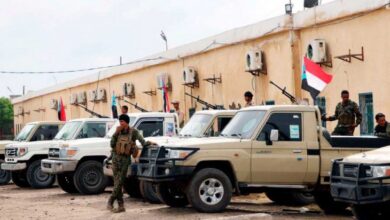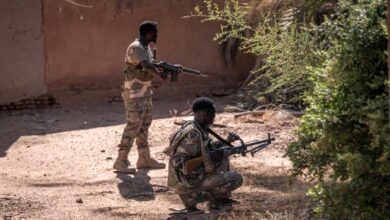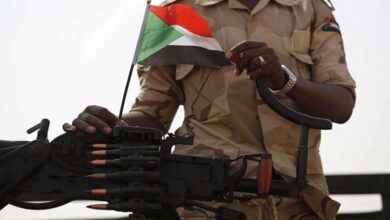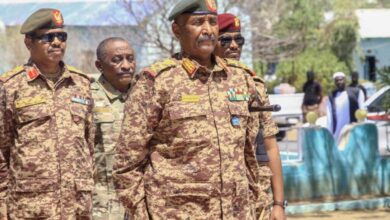From Iraq and Lebanon to Yemen and then Sudan, Iran is pressuring al-Burhan to establish a naval base on the Red Sea coast.
Iran's establishment of a naval base on the Red Sea would allow Tehran to tighten its grip on one of the world's busiest shipping lanes, aiding the Houthis in attacking commercial ships

Reports from The Wall Street Journal reveal that Iran has been pressuring Sudanese authorities to allow the construction of a permanent Iranian naval base on the Red Sea coast. However, these demands have been met with rejection by Khartoum, which fears provoking the hostility of the United States and Israel. However, Sudanese army chief Abdul Fattah al-Burhan is keen on arming his forces and maintaining close ties with Tehran, which seeks to establish a foothold in Sudan.
Iran is building a new network in Sudan, akin to Yemen, Iraq, and Lebanon
The presence of a naval base on the Red Sea would allow Tehran to strengthen its control over one of the world’s busiest shipping lanes, where the Houthis help carry out attacks against commercial ships.
A senior Sudanese intelligence official said that the presence of an Iranian base on the Red Sea would give Iran an advantage in monitoring maritime traffic to and from the Suez Canal, as well as for Israel.
Arming the Sudanese army by Iran prolongs the duration of the fighting and reduces the chances of finding an exit from the conflict through negotiation.
Ahmed Hassan Mohamed, intelligence advisor to Sudanese army chief Abdul Fattah al-Burhan, said that Iran had supplied the Sudanese army with explosive drones for use in combat against the Rapid Support Forces led by Mohammed Hamdan Dagalo “Hemetti” and had offered to provide a warship carrying a helicopter if Sudan allowed the establishment of the base.
Use of the base for intelligence gathering
The source added, “The Iranians said they wanted to use the base for intelligence gathering.” They also wanted to deploy warships there, but it was confirmed that Khartoum rejected the Iranian proposal to avoid provoking the animosity of the United States and Israel.
Under the regime of Bashar al-Assad, Sudan had strong relations with Iran and Hamas, and after his overthrow in 2019, army chief Abdul Fattah al-Burhan began attempting to reconcile with the United States to end international sanctions against his country, while also moving towards normalizing relations with Israel.
The Sudanese army has been fighting the Rapid Support Forces since mid-April, and the conflict has resulted in the deaths of tens of thousands of people, displaced millions, and caused one of the worst humanitarian crises in the world.
UN officials have criticized Sudan for bombing civilian neighborhoods and depriving Sudanese civilians of much-needed humanitarian aid.
In February of this year, the United States expressed concern about Iranian arms shipments to the Sudanese army. John Godfrey, the U.S. ambassador to Sudan at the time, said that reports of Iranian aid to Sudan were “extremely concerning and a source of great concern to us.” He added to reporters, “There are reports of the resumption of relations between Sudan and Iran that could include Iranian financial support for the Sudanese army, which is very concerning to us.”
Godfrey emphasized that the United States “urged foreign parties to refrain from providing financial support to parties in conflict” without naming them. He explained that this “prolongs the fighting and reduces the chances of finding an exit from the conflict through negotiation.”
Last month, the Rapid Support Forces posted on social media what they claimed to be wreckage of an Iranian-made “Mohajer” drone belonging to the army. Bloomberg News, citing Western officials, also reported that Iran is supplying weapons to the Sudanese army.
Wim Zwijnenburg, head of the disarmament project at the Dutch organization Pax, confirmed that among the evidence proving the presence of the Mohajer 6 in Sudan are satellite images taken on January 9th of the drone at Wadi Sayyidna Air Base (under army control) north of the capital, Khartoum.
Zwijnenburg also identified an antenna wirelessly connected to a control center inside a truck on the aircraft runway at Wadi Sayyidna Base, serving as additional evidence of the drone’s operation. According to US officials, the Mohajer 6 is capable of conducting air-to-ground attacks, electronic warfare, and targeting on the battlefield.
During the era of former President Omar al-Bashir, who was ousted from power in 2019, Sudan developed close relations with Iran. With the Sudanese army controlling areas along the Red Sea, the widespread presence of Iran would raise concerns among Western powers, while Houthi rebels in Yemen target international cargo ships on the other side of the strategic maritime corridor, in solidarity with Palestinians in Gaza.
Thousands have been killed since the outbreak of war between the Sudanese army and the Rapid Support Forces in April last year.












